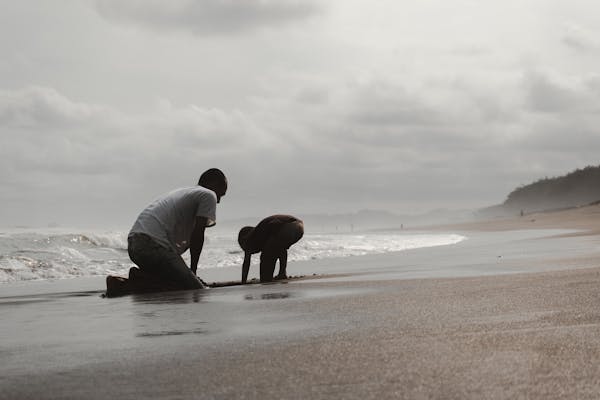

My class circled up on the playground as I walked around, passing out little cups of hot herbal tea. Hands went waving in the air, shouting, “Can I have some?” Today it was raspberry- their favorite. Some children unpacked little blankets to sit on to protect themselves from the cold snow. Others, bundled up in their snow pants, preferred to sit on tree stumps we had placed in a circle to serve as outdoor seating. I brought out a new read-aloud I knew the kids would love about the beauty of winter trees. Then we were going to look closely at the pine and hemlock trees that surrounded us. We were studying their features to discover similarities and differences so we could write about them. The kids had their nature journals attached to clipboards with prompts, “I see… I think… I wonder…”, which we use to guide many of our nature studies. With its canopy of tall evergreen trees above us, this winter playground was the setting of our science class for the day, and we were all excited to begin.
Moments like these remind me how transformational teaching during a pandemic has been for me. Like many teachers, I found myself doing things I never could have imagined doing before. One of those things has been bringing my class outside for outdoor learning. Initially, I did this because it seemed like a healthier environment for my students to learn together during a pandemic. But what I found was that the benefits from teaching outdoors are many. As a result, I picked up one new teaching strategy to build upon and share with others.
Even before the pandemic, teaching outdoors was an idea I had been harboring for a while in the back of my mind hoping to try someday. My school sits on a beautiful campus surrounded by woods, so I had been thinking for quite a while, why not use it? This was the environment my students were growing up in, and I wanted to take advantage of the natural resources around us.
Then covid struck. I found myself staring into a computer screen to see my 6-year-old students staring back at me from their muted Google Meet squares. And suddenly, I knew- it was time. I knew there had to be a better way to teach them when we couldn’t all be together safely indoors. So that is when I opened the door and said, let’s go outside.
I didn’t know what I was doing in the beginning. I am not a science teacher or a naturalist by any means. So I started small, searched for resources to help me, and found them readily available. I found out I was not the only one trying to make this happen for students. Many schools around the country were also implementing outdoor education as a safe way to bring students back to school and keep them safely together at school.
When the 2021-2022 school year began, my school returned to in-person learning with everyone wearing masks indoors. I knew I wanted to continue outdoor learning as an ongoing part of my curriculum for many reasons. So, I committed to having a Wednesday In The Woods program, where my class would spend most of the day together outdoors on Wednesdays, which is a half-day of instruction at our school. I also planned on including other outdoor lessons into our schedule throughout the week whenever possible.
Compiled here are some of the benefits I’ve found from teaching outdoors, along with resources to help you get started. It doesn’t take much to begin. Just a willingness to try and the ability to be resourceful in finding what you need. Chances are you’ll have happy, skipping children behind you, ready for the adventure.
Benefits of teaching outdoors
Research shows there are many benefits to children’s academic learning, personal development, and environmental stewardship from outdoor education. Here are a few that I have found to be most valuable.
- Outdoor learning brings joy to students and gets them more engaged and excited about their learning. Maria Montessori is famous for saying, “One test of the correctness of educational procedure is the happiness of the child.” When I tell my students we are going outdoors for a lesson, their faces light up. Being outdoors gives them space to move, run, and explore. There isn’t the same need for ongoing quiet, waiting, and listening as when working indoors. The curiosity and joyfulness being outdoors brings out in my students inspires me to continue planning more outdoor learning experiences for them.
- When safely distanced, the kids can remove their masks and breathe in the fresh air. We take in our surroundings, and our bodies relax as we spread out on our work blankets and bring out our clipboards for the day’s lesson. Increased physical activity from time spent outdoors helps us find balance in a day filled with hours of sitting indoors. Children who have difficulty regulating their bodies during indoor instruction are much calmer, focused, and engaged in instruction outdoors. Having space to move and wiggle without distracting the kids around them gives them the freedom to be who they are.
- Outdoor activities help build community and add playfulness to our classroom day. For example, having time with friends in nature- building a fort or fairy house in the woods, going on a gathering expedition or scavenger hunt together, or discovering a beautiful insect on the playground- helps build friendships, shared experiences, and positive relationships with peers. In addition, these kinds of activities teach children about teamwork and the value of working together on a task.
- Using the outdoors as a resource is a great way to bring content to life and engage students in their learning. When kids dive into place-based learning connected to their local community, they become stewards of their environment and learn to care for these local resources. Whether your school is in the middle of the woods or surrounded by city streets, there is much to learn from your school’s natural environment. By exploring the playgrounds, fields, gardens, or neighborhood parks near your school, children see that nature can exist everywhere- in the cracks of a sidewalk, under the stairs, in abandoned lots, or on the edges of neighborhood lawns- and it is our job to care for it.
7 Ideas to get you started (even in winter)
- Start small. An open space is all you need to bring your class outdoors for 30 minutes to do a read-aloud in the fresh air or take a nature walk around the neighborhood to see what signs of nature you can discover using your senses. It’s also a great way to incorporate movement breaks into your day to help regulate children who have a hard time sitting for long periods indoors.
- To make moving outdoors even more manageable, have an “outdoor kit” ready to go with all the supplies you need for teaching outside. For example, this could be a wagon with wipe boards or clipboards, markers, and foam squares to use as seating. Then you can easily throw in any other materials you need for a particular lesson and have all your supplies readily available to transport outdoors.
- Create an outdoor learning space in a convenient location. Find a spot that is easy to get to from your classroom, close to bathrooms, and away from major distractions. At my school, there is a sidewalk very close to the exterior doors leading to my classroom, which we often use to spread out for math group lessons. A nearby tree provides shade on sunny days, and it’s easy to get back inside if we forget something.
- Find seating options that are easily transportable and work for your students. Individual blankets, foam tile squares, sledding saucers, or 5-gallon paint buckets turned upside down are all great options. Tree stumps, though not as portable, also make excellent seating options!
- Be prepared for the weather. An old saying from Scandinavia goes, “There’s no such thing as bad weather, only bad clothes.” This is undoubtedly true for outdoor education. Invest in suitable clothing that will keep you warm on cold days and dry on rainy days so you can go outside in all weather as long as it is safe. In addition, teach your students how to prepare for the weather and give parents tips on dressing children warmly. Some schools seek donations from sites such as Donors Choose to create a lending closet with extra rain and snow gear on hand for children who do not have appropriate clothing. Also, check out your local thrift store, or ask families who have outgrown their winter clothing for donations so you can always have extra gear on hand for students who need it. The adventure of huddling up together, sipping mugs of hot tea on a frigid day, or searching around a vernal pool in the drizzling rain to discover frog eggs on a rainy day, are some of my favorite memories of being outdoors with my students. Being outdoors in all weather teaches children how to build resilience and face challenges even when it is difficult (and not always comfortable) to do so.
- Set boundaries for safety with your students whenever you are outdoors. Begin your outdoor time together by identifying the space you will be using to learn and make a note of any safety hazards nearby to be cautious of (parking lots, roads, poison ivy, a broken fence, etc.) Outdoor lessons can begin the same way as they would in the classroom, by circling up and putting eyes on the speaker. Establishing outdoor routines and boundaries helps children see the space as an outdoor classroom, which is different from being outdoors during recess time.
- Assess the spaces around your school, and talk to community members about how they might be transformed into greener spaces. Enlist the help of community members in creating spaces near your school that would be good for outdoor learning. While it might be more natural to think of building outdoor classrooms in rural areas, it’s possible to envision and create outdoor spaces in urban areas, where existing infrastructure can be transformed into outdoor learning spaces to meet the needs of a school. For example, explore neighborhood parks, grassy areas, courtyards, or construct garden beds on school grounds to grow vegetables and flowers. There are many examples of urban schools that have transformed their schoolyards to create inviting outdoor spaces for children to learn.
Resources To Guide You
- Transferring parts of your instruction to outdoor learning is not an easy task. Seek support from other teachers who are striving to do the same thing. One place to look is Inside-Outside, a community of Nature-Based educators who provide teachers with resources and inspiration to open the door and head outside. Their position statements are full of helpful ideas, solid research, and all the information you need to begin.
- A Forest Days Handbook is an easy-to-read handbook, which is very helpful in explaining how to establish routines, schedules, and learning spaces for being outdoors. It will help you begin planning for outdoor instruction and gives plenty of examples of the work other classrooms are doing. The information is easy to access, can be applied to different grade levels, and provides essential questions to consider when designing your program.
- Green Schoolyards America is another supportive community to learn from. Their website is full of helpful resources and examples of schools around the country implementing outdoor education for their students.
If you are looking to breathe some fresh air into your classroom environment, try teaching outdoors! All you need is a willing spirit, a sense of adventure, and the desire to open the door to a new way of learning for your students. Joy, balance, and well-being may be a few of the many benefits you will find.








